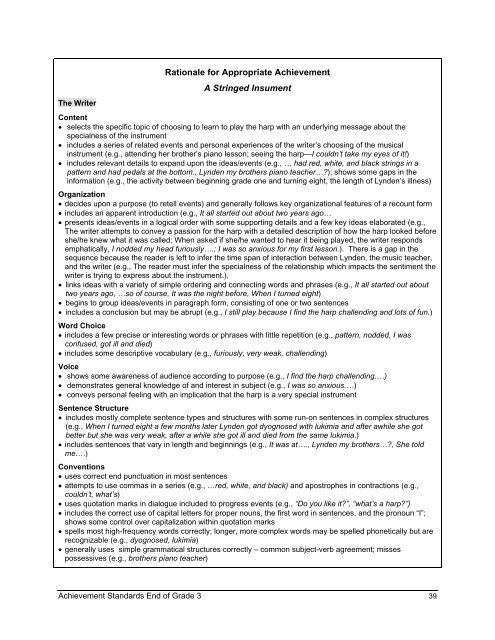Reading and Writing Achievement Standards Curriculum
Reading and Writing Achievement Standards Curriculum
Reading and Writing Achievement Standards Curriculum
Create successful ePaper yourself
Turn your PDF publications into a flip-book with our unique Google optimized e-Paper software.
The Writer<br />
Rationale for Appropriate <strong>Achievement</strong><br />
A Stringed Insument<br />
Content<br />
• selects the specific topic of choosing to learn to play the harp with an underlying message about the<br />
specialness of the instrument<br />
• includes a series of related events <strong>and</strong> personal experiences of the writer’s choosing of the musical<br />
instrument (e.g., attending her brother’s piano lesson; seeing the harp—I couldn’t take my eyes of it!)<br />
• includes relevant details to exp<strong>and</strong> upon the ideas/events (e.g., … had red, white, <strong>and</strong> black strings in a<br />
pattern <strong>and</strong> had pedals at the bottom., Lynden my brothers piano teacher…?); shows some gaps in the<br />
information (e.g., the activity between beginning grade one <strong>and</strong> turning eight, the length of Lynden’s illness)<br />
Organization<br />
• decides upon a purpose (to retell events) <strong>and</strong> generally follows key organizational features of a recount form<br />
• includes an apparent introduction (e.g., It all started out about two years ago…<br />
• presents ideas/events in a logical order with some supporting details <strong>and</strong> a few key ideas elaborated (e.g.,<br />
The writer attempts to convey a passion for the harp with a detailed description of how the harp looked before<br />
she/he knew what it was called; When asked if she/he wanted to hear it being played, the writer responds<br />
emphatically, I nodded my head furiously….; I was so anxious for my first lesson.). There is a gap in the<br />
sequence because the reader is left to infer the time span of interaction between Lynden, the music teacher,<br />
<strong>and</strong> the writer (e.g., The reader must infer the specialness of the relationship which impacts the sentiment the<br />
writer is trying to express about the instrument.).<br />
• links ideas with a variety of simple ordering <strong>and</strong> connecting words <strong>and</strong> phrases (e.g., It all started out about<br />
two years ago, …so of course, It was the night before, When I turned eight)<br />
• begins to group ideas/events in paragraph form, consisting of one or two sentences<br />
• includes a conclusion but may be abrupt (e.g., I still play because I find the harp challending <strong>and</strong> lots of fun.)<br />
Word Choice<br />
• includes a few precise or interesting words or phrases with little repetition (e.g., pattern, nodded, I was<br />
confused, got ill <strong>and</strong> died)<br />
• includes some descriptive vocabulary (e.g., furiously, very weak, challending)<br />
Voice<br />
• shows some awareness of audience according to purpose (e.g., I find the harp challending.…)<br />
• demonstrates general knowledge of <strong>and</strong> interest in subject (e.g., I was so anxious.…)<br />
• conveys personal feeling with an implication that the harp is a very special instrument<br />
Sentence Structure<br />
• includes mostly complete sentence types <strong>and</strong> structures with some run-on sentences in complex structures<br />
(e.g., When I turned eight a few months later Lynden got dyognosed with lukimia <strong>and</strong> after awhile she got<br />
better but she was very weak, after a while she got ill <strong>and</strong> died from the same lukimia.)<br />
• includes sentences that vary in length <strong>and</strong> beginnings (e.g., It was at…., Lynden my brothers…?, She told<br />
me.…)<br />
Conventions<br />
• uses correct end punctuation in most sentences<br />
• attempts to use commas in a series (e.g., …red, white, <strong>and</strong> black) <strong>and</strong> apostrophes in contractions (e.g.,<br />
couldn’t, what’s)<br />
• uses quotation marks in dialogue included to progress events (e.g., “Do you like it?”, “what’s a harp?”)<br />
• includes the correct use of capital letters for proper nouns, the first word in sentences, <strong>and</strong> the pronoun “I”;<br />
shows some control over capitalization within quotation marks<br />
• spells most high-frequency words correctly; longer, more complex words may be spelled phonetically but are<br />
recognizable (e.g., dyognosed, lukimia)<br />
• generally uses simple grammatical structures correctly – common subject-verb agreement; misses<br />
possessives (e.g., brothers piano teacher)<br />
<strong>Achievement</strong> St<strong>and</strong>ards End of Grade 3 39
















